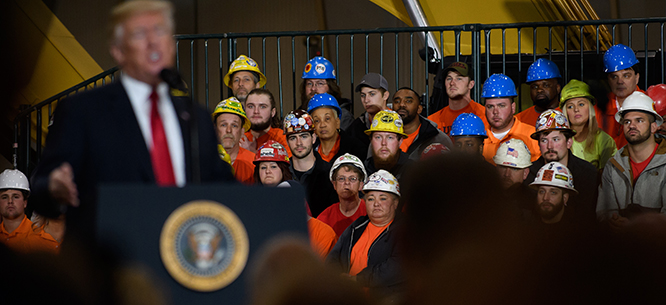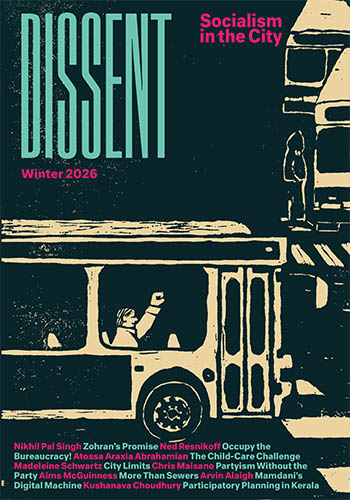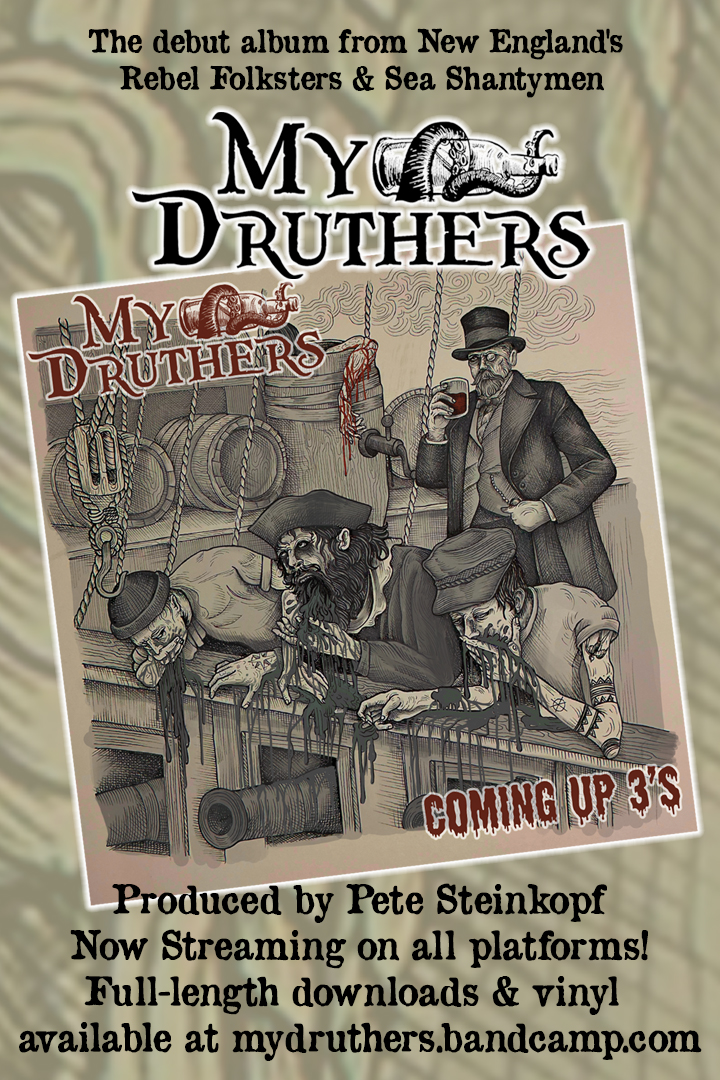The Decline of Union Hall Politics
The Decline of Union Hall Politics
To become a party based among workers again, Democrats must remember that partisan commitment often grows from local roots.

Everybody knows most white working people no longer vote for Democrats, but there’s no agreement why. Leftists blame neoliberals for enacting policies that deregulated business instead of redistributing wealth. Conservatives and some liberals argue that the fault lies in cultural ideas and principles that progressives have compelled Democrats to embrace—from transgender rights and restrictions on gun ownership to critical race theory and a dismissal of religious faith. Others, echoing the Marxist notion of “false consciousness,” accuse ordinary white people of fearing Black Americans and undocumented immigrants instead of making common cause with fellow workers of different racial or national backgrounds.
Whatever insights these explanations offer should be qualified with a healthy dose of historical perspective. Back in the middle of the last century, Democrats routinely won the votes of white working people who were, if anything, more culturally conservative and accepting of racist myths and structures than they are now. And despite having tiny majorities in Congress or none at all, Democrats during the tenure of Joe Biden have made a serious effort to enact policies on trade, infrastructure, child care, student loan forgiveness, green jobs, and labor law that represent a decisive turn away from the corporate-friendly stance Bill Clinton adopted three decades ago. Still, the president from Arkansas surged to reelection in 1996 with huge majorities among white voters with a high school education or less. They backed him even though, with the help of Republicans, he had pushed a free trade agreement through Congress that shrank the number of good union jobs available in U.S. factories.
A primary reason why the “party of the people” once secured the allegiance of working-class Americans was that a sizeable number belonged to labor unions in the private sector. Through their leaders and official periodicals, those unions routinely taught them that the Democrats, whatever their flaws, were the only party that looked out for their interests instead of catering to those of wealthy Americans. Who had enacted Social Security and Medicare, protected the right to organize, and called for lowering their taxes and raising them on corporations and the rich? Some of the biggest industrial unions—the United Auto Workers (UAW), United Steelworkers (USW), and United Mine Workers (UMW)—were also interracial oases in a segregated society. The gradual but steady decline of unions in the private sector, from 35 percent in the mid-1950s to a mere 6 percent today, cleared the way for conservative churches, right-wing networks and social media, and the National Rifle Association to conduct their own kind of political education—and quite effectively too.
The modest revival of unions, ardently supported by Biden and his appointees to the National Labor Relations Board, stirs hope that Democrats might win back a sizeable percentage of those white voters again. If the party also retained its growing edge among college-educated voters of all races, Democrats would be able to forge a new majority coalition—something that has not existed in the United States since the New Deal order crumbled at the end of the 1960s.
However, as Lainey Newman and Theda Skocpol argue in their recent book, Rust Belt Union Blues: Why Working-Class Voters Are Turning Away from the Democratic Party, it is not the mere fact of belonging to a union but the character of the organization that can make an electoral difference. A local where members build a community of shared interests outside the workplace can sway white workers to stick with Democrats. But one that treats them mainly as anonymous dues-payers can leave them either indifferent or hostile to the party the union’s leaders still endorse. Genuine solidarity gives members a reason to trust the choice those leaders make; indifference breeds suspicion and a search for other kinds of networks in which to find friendship and meaning. Newman and Skocpol study a richly detailed microcosm of the problem: steelworkers and electrical workers in western Pennsylvania—a bastion of liberal Democrats during the New Deal Era that, outside of Pittsburgh, has become a Donald Trump stronghold.
Back in the 1960s, they write, “Being a union man did not stop when a worker left the gates of the steel mill or auto factory.” Members of the USW in Aliquippa, home to a big Jones and Laughlin mill, also “read the local labor newspaper”—which circulated to a majority of residents—and “played in or watched the union’s softball or bowling league.” The union hall was just one of thirty-seven that served steel towns in the region. The Aliquippa local and others like it also had overlapping memberships with fraternal lodges and ethnic organizations built by immigrants whose progeny toiled in the mills of western Pennsylvania. The strong union also ensured its members a relatively secure job at a wage high enough to buy a modest home and take a paid vacation—achievements enjoyed by few American factory workers before the 1940s.
That the union played a pleasing and often essential role in their lives also gave credence to its advice about how to use the government and for whom they should vote. The union’s Aliquippa Steelworker informed its readers about hunting regulations as well as how to navigate Medicare and reminded them that Republicans in their state and nation were close allies of anti-labor employers. The result, recalled one retiree, was that he “could not go to the steel mill or mine and find a guy who would vote for a Republican. . . . They figure there was not a Republican in the world who took care of a working guy.” This leads Newman and Skocpol to make a point many pundits neglect, although its wisdom should be obvious: most people vote according to “constantly reinforced involvements that informed who they were.” For steelworkers and those living near them, this meant their “social identities as union men or union family members and their regional identities as good neighbors in union-influenced communities.”
As the union-centered world of steelworkers and their friends and families eroded, their preference for Democrats vanished along with it. Competition from more efficient and lower-wage facilities abroad led to plant closings across the region that, to the anxious frustration of its residents, became known as the Rust Belt. The United Steelworkers rallied communities to fight plant shutdowns but failed to withstand market forces and the diffidence of most politicians in the Reagan era. The mill in Aliquippa that had once employed close to 10,000 people shut down for good in 1984.
A few steel factories still operate across western Pennsylvania, but the once mighty union now represents fewer than 10,000 employees in the region and no longer holds a central place in their lives. Company towns have disappeared, so wage-earners often have longer commutes and don’t frequent the union hall after the workday ends. As a result, most of those gathering places have closed down. “We used to have meetings at 7:30 at night,” recalls a USW official poignantly, but members weren’t coming, “so we started having them right after work at 4:15. We tried cooking food, we tried to get pizzas, give tickets away or jackets—it still doesn’t entice the people to come.”
That human beings long to participate in a community may be a cliché, but many white workers who used to have one in their unions have found alternatives where the political talk leans hard to the right. They join gun clubs where NRA membership is required and attend megachurches whose pastors inveigh against marriage equality and abortion (and are wary of “secular” unions). Early in 2021, to learn something about the causes that move steel unionists, Newman, a sociologist, walked around the parking lots of three plants in the region to photograph what types of stickers workers were plastering on their cars. Most touted hunting, guns, Trump, or the GOP. A smaller number championed the union, while just over 1 percent saluted any Democratic candidate, and nearly all of those were for candidates the USW had endorsed.
Something of the old emotional solidarity continues to thrive in a different type of union, however. The skilled workers who belong to the International Brotherhood of Electrical Workers (IBEW) find high-wage employment in a variety of industries—from construction and public utilities to manufacturing and media. That versatility means they bond more through a common craft than by sharing the same workplace or living in the same town. Given that reality, the IBEW has long cultivated a sense of community by publishing magazines and newsletters stuffed with photos of local members and their families and by scheduling meetings and outings in a variety of places where clusters of electricians live. That the IBEW plays an active and welcome role in the lives of its members gives officials a better chance of persuading them to vote for Democrats, while the USW struggles to retain a dwindling number of dues-payers and expends little effort to shape their political views.
To learn that most members of a craft union still lean to the party of Franklin D. Roosevelt and Biden while those in an industrial union have migrated to Trump defies the conventional wisdom of many labor historians and left activists. The latter have often bashed craft unions as havens of “labor aristocrats” who allegedly look down on or actively discriminate against workers who are not white or male—and oppose big industrial organizing drives as too costly or risky.
That condemnation was always too simplistic. In the early twentieth century, the American Federation of Labor, most commonly known as the home of craft unions, included large industrial unions in coal, beer-making, and the garment trades and waged an epic but unsuccessful strike to organize the steel industry after the end of the First World War. The UMW opened its ranks to Black people before most unions did, and a large number of clothes makers were women. Even after the Congress of Industrial Organizations managed to organize workers in such basic industries as auto and steel in the 1930s, the AFL outpaced its numbers. When the two federations merged in 1955, the AFL’s unions boasted twice as many members as the newer organization.
And today it is probably the industrial unions, most with roots in the CIO, that struggle to convince their members that the portion of their dues that goes to political campaigns is well spent. Such workers, write the authors, “have developed a new sense of shared identity rooted in . . . resentments against the places and constituencies they see now at the core of the Democratic Party.” The targets of their anger include environmentalists and college-educated professionals. Many Pennsylvanians who belong to the Steelworkers feel that the leaders and staffers in the Pittsburgh headquarters care more about fundraising for political goals than about reviving the kind of union spirit that helped motivate their earlier counterparts to vote for Democrats. “Sheer staff growth and more money shoveled into political campaigns do not necessarily translate into rank-and-file votes,” Newman and Skocpol write.
The UAW appears to be an exception to this unfortunate trend. Under the leadership of Shawn Fain, the UAW won sizeable wage increases from the Big Three carmakers and union recognition at the Volkswagen plant in Chattanooga—the first such union victory at a foreign-owned vehicle plant in the notoriously anti-labor, right-to-work South. Whether the UAW’s endorsement of Kamala Harris will lift her to victory in Michigan, where it has far more members than in any other state, remains an open question. Anxiety about the transition to electric cars, pushed hard by the Biden administration, runs deep there. And if Harris can’t win Michigan, she almost certainly won’t be elected.
The old division between craft and industrial unions has also become increasingly obsolete. Some of the largest unions in the private sector now are hybrids of the two. The Service Employees International Union began as an organization of janitors, but its 2 million members include child- care providers, aircraft cleaners, and physicians. And over a quarter of the members of the UAW hold jobs in academia, not car plants. Moreover, the educated professionals who belong to the biggest unions in the public sector—the American Federation of Teachers and the American Federation of State, County & Municipal Employees—are among the most stalwart Democratic campaigners and progressive activists in the nation. Today, even the building trades have rejected their racist heritage and rush to sign up African-American and Latino apprentices.
Drives among workers who identify with a trade have also been among the most successful in the embryonic union revival. At dozens of universities, public and private, graduate students have chosen to organize by lopsided margins. The Association of Flight Attendants-CWA, led by the charismatic Sara Nelson, represents nearly 50,000 workers employed by most U.S. airlines and is aggressively seeking to sign up those at Delta, which has the largest nonunionized workforce in the industry. Some 10,000 baristas at over 400 Starbucks outlets have gone union. And with the support of other Hollywood crafts, the long strike by writers and actors in 2023 compelled the big studios to settle on more favorable terms than expected. This fall, such zealous unionists will surely vote for Democrats—if they vote at all.
What Newman and Skocpol discovered about the politics of IBEW members in Pennsylvania may be occurring nationally. Workers enmeshed in cultural networks based on the jobs they perform—often with pride—are more likely to cherish their unions and support Democrats who want to expand the power of labor in American life. Some industrial unions have nurtured these connections too. In Las Vegas, the officials of Local 226 of the Culinary Workers help the largely immigrant workforce that staffs most of the hotels and casinos to prepare for citizenship exams and runs a pharmacy where members get their prescriptions filled for free. The union also holds political education sessions, rents buses to transport members to the polls, and organizes a massive house-to-house canvas during every campaign. Without the local’s efforts, Democrats would lose nearly every big race in Nevada, one of the swingiest states in the nation.
To boost their electoral fortunes as well as improve the lives of wage earners, Democrats should, of course, do all they can to make it possible for the roughly 60 million Americans who want to join a union to do so. But politicians cannot organize workers; they can only fight to remove some of the barriers thrown up by corporations, courts, and right-wing lawmakers to that purpose. The Protecting the Right to Organize Act, which passed the House of Representatives in 2021 but predictably failed to overcome a filibuster in the Senate, would help achieve that aim.
But neither a good law nor better messaging will be enough to turn “union blues” into a solid, progressive, working-class bloc in the Rust Belt and elsewhere. As Newman and Skocpol suggest, partisan commitment often springs from local roots, particularly among working people who spend most of their lives in a single part of the country and, either by choice or necessity, do not move around to pursue their careers. To become a party based among workers again, Democrats will need not just social movements on their side but networks, clusters, and affinity groups on the job and in neighborhoods upon whom people can rely for companionship and support in hard times.
How to connect those emotional attachments to the political decisions individuals make is a difficult, if urgent, question. At a time when so many Americans engage more with their phones than with any collective endeavor, that will not be easy. But the alternative is to submit to the designs of celebrity politicians who spout lies and conspiracy theories.
The notion of some leftists that unions can revive without aid from the state and from a major governing party is and has always been a fantasy. Since its birth in the nineteenth century, the American labor movement has been endorsing politicians and fighting for laws that would improve workers’ lives on and off the job. Support from the state continues to be critical to a healthy and enduring revival of the movement. As the historian Nelson Lichtenstein wrote recently, “The union movement’s comeback in recent years could not have taken place without the existence of a set of political initiatives that generated both low unemployment and a high level of government-guided business investment.”
In 1903, Clarence Darrow, the renowned left-wing attorney, was representing the UMW before a commission empowered to arbitrate the wages and conditions of the men who mined the black rock that heated millions of American homes. He extolled unions as “the greatest agency that the wit of man has ever devised for uplifting the lowly and the weak, for defending the poor and the oppressed, for bringing about genuine democracy amongst men.” It’s a grand sentiment. But unionists can only generate the force they need if they and the Democrats who support them learn how to build true solidarity in a society that does everything to discourage it.
Michael Kazin is an editor emeritus of Dissent. His most recent book is What It Took to Win: A History of the Democratic Party.






